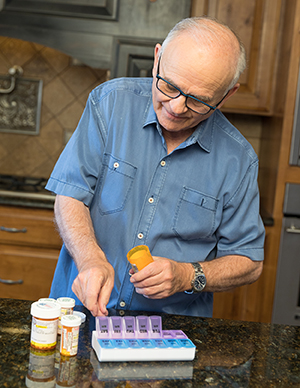After Your Transcatheter Aortic Valve Replacement (TAVR)
You have just had surgery to replace your aortic valve with a new biological tissue valve. When you go home, follow all instructions you receive from your healthcare provider for medicines, pain control, diet, activity, and wound care. Make sure to keep all your follow-up appointments. You should feel better after your surgery. But complete recovery may take several weeks. How long depends on whether the surgery was done through your groin, underneath the collarbone, or between your ribs. All of these methods are considered less invasive than open heart surgery. This means fewer complications and a shorter recovery time. Below are some general guidelines to follow as you heal.
Recovering at home
Follow your healthcare provider’s directions for recovery at home. It may take several weeks to get back to your normal routine. Using the groin artery is the least invasive method and heals the fastest. TAVR done between your ribs needs a larger incision and takes longer to recover from.
 |
| A pill organizer can help you keep track of the medicines you take each day. |
During your recovery:
-
Take medicine as directed. Take pain medicine, blood thinners, and any other medicine exactly as your healthcare provider advises. You will likely need to take aspirin and another blood thinner (antiplatelet) for a period. You’ll need to take the aspirin for the rest of your life. Be sure your healthcare provider knows about all other medicines you take, including over-the-counter medicines and dietary supplements.
-
Care for your incision. It’s normal for your incision to be bruised, itchy, or sore while it’s healing. Your incision may take a week or more to heal. A surgery site between your ribs will take longer to heal than one in your groin. Care for the bandage and incision as advised. Don’t put powder, lotion, or ointment on the incision until it’s healed. If you notice swelling, redness, any discharge, or excessive bruising at the site, call your healthcare provider right away.
-
Shower carefully. Unless you’re told otherwise, you can shower once you get home. Use warm water and a mild soap. Don't use hot water because it can make you feel lightheaded. Don’t take a bath until your healthcare provider says it’s OK. Also don’t sit in a swimming pool or hot tub until your healthcare provider says it’s OK. If your surgery was between your ribs, you may need to keep the incision site dry for a certain period.
-
Do only activities your healthcare provider tells you are OK. Your healthcare provider may tell you not to do strenuous activities for a week or more. This includes no heavy lifting. Instructions on what to do are different depending on how your surgery was done. Your healthcare provider will give you specific instructions that are appropriate for you.
-
Don’t drive if you are taking opioid pain medicine. These medicines can make you feel sleepy, and it is unsafe to drive or operate heavy machinery while taking them.
-
Walk regularly. One of the best ways to get stronger is to walk. If your healthcare provider agrees, start with short walks at home. Walk a little more each day. Take someone with you until you feel OK to walk alone. Your healthcare provider may recommend a cardiac rehab program. This will allow you to be closely monitored by trained personnel during exercise. Most insurance companies will cover these programs.
Call 911
Call 911 right away if you have:
When to call your healthcare provider
Call your healthcare provider right away if you have any of the following symptoms:
-
Bowel movement that is bright red
-
Bleeding that is frequent or persistent, such as nosebleeds
-
Chills or fever of 100.4°F (38°C) or higher, or as directed by your healthcare provider
-
Dizziness or lightheadedness
-
Redness, swelling, bleeding, warmth, or fluid draining at the incision site
-
Weight gain of more than 2 to 3 pounds in 24 hours or more than 5 pounds in 1 week
-
Swelling in your hands, feet, or ankles
-
Shortness of breath that doesn’t get better when you rest
-
Pain that gets worse or doesn’t go away
-
Fast, slow, or irregular pulse
-
Worsening or severe fatigue
-
Other signs or symptoms as advised by your healthcare provider
Follow-up care
Follow-up visits with your healthcare provider help make sure you’re recovering well. In fact, to keep feeling your best, you’ll need regular checkups for the rest of your life. During these visits, you may have:
-
Blood tests to monitor the function of your heart and kidneys, and check for anemia
-
Echocardiograms to check how well your heart and new heart valve are working
-
Electrocardiograms (ECGs) to show if your heart rhythm has changed after your valve replacement
Staying healthy after a heart valve replacement
-
Learn to take your own blood pressure and pulse. Keep a record of your results. Ask your healthcare provider which readings mean that you need medical care.
-
Weigh yourself every day and keep a record of this. It's normal for your weight to fluctuate 2 to 3 pounds in a day, anything more than this could mean you are retaining fluid and developing heart failure. Tell your healthcare provider right away if this is the case.
-
Tell all your healthcare providers and dentists you’ve had a valve replacement. Before any dental procedure, you will need to take an antibiotic to protect your new heart valve.
-
Take any prescribed blood thinners exactly as directed.
-
Make lifestyle changes as advised by your healthcare provider. Keep in mind that healthy habits, such as exercise, and a healthy diet can strengthen your heart.
-
Alert your healthcare provider to any new symptoms.